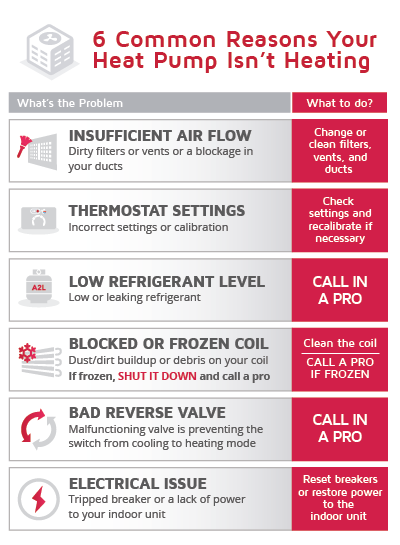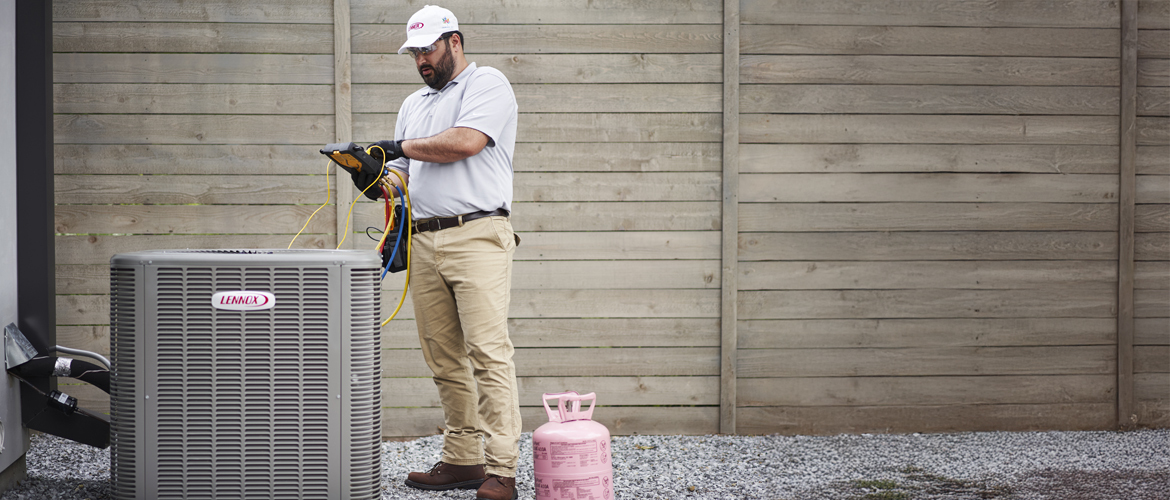In order to keep your heat pump performing efficiently, it helps to understand how it works, and the steps you can do to ensure it keeps you and your family comfortable for years to come.
How Heat Pumps Work
The heat pump was designed as a single-unit alternative to the traditional air conditioner and furnace combination. What makes a heat pump different is its ability to reverse that cycle, allowing it to deliver cooling or warming air as needed. Paired with an indoor air handler, a heat pump is capable of heating and cooling your home year-round, eliminating the need for a gas furnace.
The Roles of Indoor and Outdoor Equipment
Whether a part of a traditional ducted whole-home system or a simpler ductless mini-split, every heat pump system requires two primary components to do its job – an outdoor condenser and an indoor evaporator. Working together, these units use condensation and evaporation to heat and cool your home using a process called the refrigerant cycle.
The Indoor Unit
The indoor air handler consists of an evaporator coil and a blower fan to distribute air throughout the home.
When in heating mode, hot, high-pressure refrigerant enters the indoor evaporator coil. As it circulates, it releases much of its heat through evaporation. Meanwhile, the fan is pulling cold air from the home, blowing it across the hot evaporator coil, and circulating it back into the home. After it leaves the evaporator coil, the cooled refrigerant travels to the outdoor unit.
The Outdoor Unit
The true “heat pump” in the equation, the outdoor component is what makes the system dual-purpose. It consists of a compressor, a condenser coil, and a reversing valve that controls the mode.
Still under high pressure, the refrigerant passes through an expansion valve, where the pressure is bled off, cooling it further. The now cold low-pressure refrigerant enters the condenser coil where it absorbs heat from the outdoor air. The compressor then applies pressure, reheating it before it’s sent back to the indoor unit to warm the home.
This cycle continues until the desired indoor temperature is reached.
Cooling mode uses the same process, but in the opposite direction. The refrigerant flow is reversed allowing the system to absorb heat from the indoor air and release it outdoors, cooling the home.

Some Common Reasons a Heat Pump Isn’t Heating
There are a number issues that can cause a heat pump to blow cold air or take longer than usual to heat up. They can range from simple issues that most homeowners can address themselves to more complicated ones that require the attention of a technician.
Here’s a list of common issues that could be hampering your heat pump’s performance:
Insufficient Air Flow
Blocked or clogged filters or ducts are the most common cause for reduced performance in most HVAC systems. Restricted airflow will cause your heat pump to work harder than necessary to do its job. This can create long run periods, unusual start/stop frequency, and poor circulation throughout your home.
Incorrectly Set or Malfunctioning Thermostat
Today’s smart digital thermostats can be difficult to use for some. Improper calibration or faulty thermostat setup can lead to unexpected results and could be the culprit behind your heat pumps poor performance.
Low Refrigerant Level
Leaking or low refrigerant can make for an inefficient refrigerant cycle, preventing your heat pump from transferring heat effectively from one space to another.
Note: Diagnosing a refrigerant leak requires special equipment and training to determine pressure levels and detect any escaping refrigerant. Always call in a professional if you suspect this may be the issue.
Blocked or Frozen Outdoor Coil
A buildup of dust or debris around the outdoor unit can also cause performance issues. Unrestricted airflow is critical to the condensation and evaporation processes the system requires. A restricted coil can lose its ability to transfer heat effectively, causing it to freeze up, and resulting in a break down or poor performance.
Bad Reversing Valve
The reversing valve allows a heat pump to change its mode with the seasons. If cold weather hits and your heat pump continues to blow cool air, a faulty reverse valve may be the issue.
Electrical Issue or Lack of Indoor Unit Power
A lack of power due to a circuit breaker could also be the cause. A power surge of some kind may have tripped the breaker that connects your heat pump to its power. A simple reset of the tripped breaker will solve this issue.
Also, outdoor units will typically not power on if their indoor counterpart is not powered up. Your heat pump may be offline if for some reason your air handler has been powered off, or its circuit breaker has been tripped.
Freezing Temps
If your heat pump isn’t keeping your home warm during a deep freeze, the outdoor temperature could be the culprit. Standard heat pumps are designed to operate efficiently in moderate climates, but when temperatures dip below freezing (typically around 25°F to 30°F) they struggle to extract enough heat from the outside air to warm your home effectively. This performance drop is a common limitation of traditional single-stage and two-stage systems.
In colder regions, a cold-climate heat pump may be a better solution. These models are specifically engineered to handle extreme temperatures, often continuing to provide efficient heating even when it's below zero. If you find yourself relying more on backup heat or noticing a chill indoors during cold snaps, it might be time to consider upgrading to a system built for your climate.
Steps You Can Take to Restore Your Heat
Before calling in a technician, there are a few steps you may be able to take to try to restore your heat.
• Check Your Filters, Ducts, and Ductwork for Blockages
• Inspect the Outdoor Unit for Debris or Ice Buildup
• Check Your Thermostat Settings
While you can likely address air flow issues and clear debris from around your equipment, most of the causes we covered require the skills of a trained technician. Consult with a local HVAC professional if you’re unable to easily restore your heat.
Remember: Proper Maintenance = Problem Prevention
As we mentioned, a common cause of reduced performance from a heat pump, or any piece of HVAC equipment is a lack of regular, timely maintenance. And the best way to ensure your equipment will run efficiently now and long into the future is to keep up with that maintenance.
Simply changing your filters according to the manufacturer’s recommendations, cleaning your ducts and equipment regularly, and checking for air flow issues periodically can help prevent overworked equipment and avoid future problems – large and small.
Know When to Call a Pro
A heat pump is a complicated piece of equipment, and you’re not always going to be able to identify or correct a problem yourself.
If your unit continues to perform below expectation or you notice additional issues, give your local Lennox dealer a call and schedule a service visit to identify the issue. They can help you get your heat pump working, or if the issue is larger, recommend an efficient new Lennox unit to replace your old one.
This has been reviewed by Justin Huntington, Director of Product Management – Indoor Cooling, for accuracy. Justin brings over 12 years of expertise in the HVAC space.

